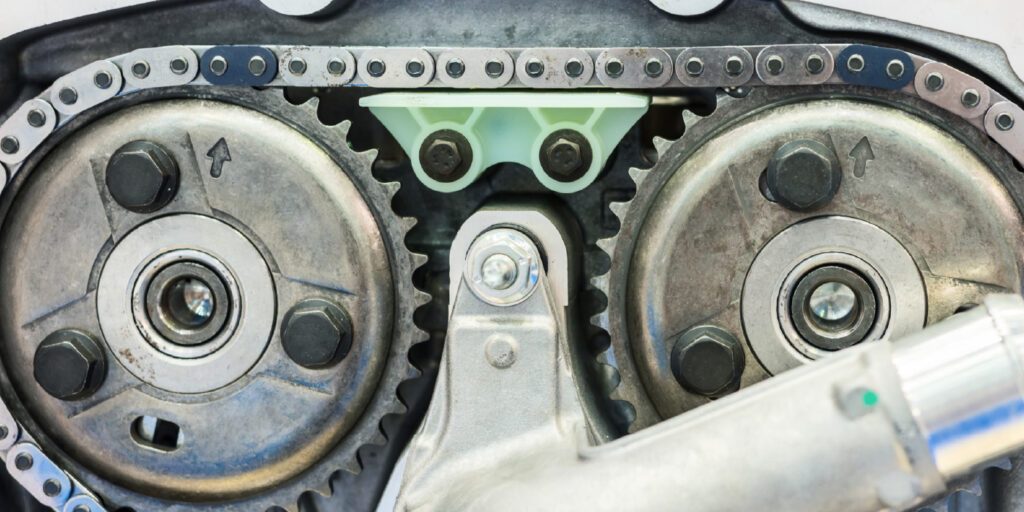All gasoline engines have a spark ignition system to ignite the air/fuel mixture in the cylinders. The spark is created by a high-voltage surge from an ignition coil. The coil is triggered by an ignition module and/or the PCM using a signal from a distributor pickup or crankshaft position sensor. If the engine has a distributor, a single coil is used on most engines to supply high voltage to all the spark plugs (a few Japanese applications use two coils). If the engine has a “distributorless ignition system“ (DIS), each spark plug has its own separate coil. On General Motors’ “waste spark” DIS systems, two spark plugs share the same coil. Many newer vehicles have coils that are mounted directly over the spark plug and use no plug wires. These are called “coil-on-plug” (COP) ignition systems. Another variation is “coil-near-plug” (CNP) systems that mount individual coils near the spark plugs and connect the coils to the plugs with short wires.
Ignition coils come in various shapes and sizes, but all do essentially the same thing: They are step-up transformers that convert 12 volts DC into 7,000 to 40,000 or more volts DC. The actual voltage required to fire a spark plug depends on engine speed, load, temperature, resistance in the plug and wires, and the distance across the spark plug electrodes.
Inside the coil are two sets of copper wire windings, one inside the other. If the coil windings short out or break, the coil may not produce enough voltage to fire the spark plugs causing the engine to run rough or die. Hairline cracks in the coil housing or insulation can also weaken or kill the spark. Coils can be tested by measuring their primary and secondary resistance with an ohmmeter or a spark tester. Replacement coils must be the same type as the original to match the engine’s voltage requirements.
Electronic ignition systems all use some type of transistorized switching module to turn the coil(s) on and off. On some vehicles (GM and Ford), the module may be mounted on or in the distributor. On DIS systems, it is often part of the coil pack assembly. Modules can be damaged by heat and vibration. A module failure will usually cause a no-spark, no-start condition. GM High Energy Ignition (HEI) modules in older vehicles require a thin layer of dielectric grease underneath to conduct heat away from the module. If your customer forgets the grease, the module may not live very long.
Ignition modules may receive a trigger signal directly from a distributor pickup (magnetic, Hall effect or optical), a crankshaft position sensor or the PCM. A fault in any of these other components or the wiring can prevent the ignition system from firing. Accurate diagnosis is essential to prevent unnecessary parts replacements and returns.
If a vehicle has a distributor, the cap and rotor may develop carbon tracks and cracks over time. This can lead to ignition misfire and hard starting. Replacing the cap and rotor when the spark plugs are changed is often necessary to restore “like-new” ignition performance.
Plug wires connect the distributor or individual coils to the spark plugs. Also called ignition cables, they come in various types (suppression and solid core — also called “mag” wires) and with various types and grades of insulation and jacketing (silicone, EPDM and other materials). The higher the temperature resistance of the insulation and jacketing, the better. Cable diameters are usually 7 or 8 mm and each cable is a different length to fit specific spark plugs. Replacement cables must be the same size and length as the original. Plug wires may be replaced individually or in complete sets (wires should be changed one at a time to avoid mixing up the firing order). Replacement is needed if internal resistance in the wires exceeds specifications, the wiring is damaged, or the plug boots or terminals fit poorly or are loose.
Finally, we come to the business end of the ignition system: the spark plugs. Spark plugs come in different sizes, lengths, threads and electrode configurations, but all have some type of center electrode surrounded by a ceramic insulator in a threaded steel shell. Most long-life spark plugs have electrodes made of platinum or iridium and have a service life of 100,000 miles. The “heat range” (operating temperature) of a spark plug depends on the length and shape of the ceramic insulator. The spark plug has to run hot enough so fuel deposits don’t build up on the tip, foul the electrode and cause it to misfire. But it also has to conduct enough heat away from the tip so the tip doesn’t get too hot when the engine is under load and cause pre-ignition. Many spark plugs have a “copper core” center electrode that improves heat conduction and gives the plug a broader operating range.
Spark plugs are designed for specific engines. The diameter, length and pitch of the threads that screw into the cylinder head must match the application. How far the tip of the spark plug extends into the combustion chamber (called “reach”) must also be correct for the application, otherwise the tip of the plug may hit the piston or valves. Always follow the spark plug listings in your plug supplier’s catalog.
The distance across the electrode gap at the end of the spark plug must also be set to certain specifications for the engine to run properly. If the gap is too narrow, the spark may not be long enough to ignite the fuel mixture reliably, resulting in ignition misfire. If the gap is too wide, there may not be enough available voltage to create a spark, also causing ignition misfire.











